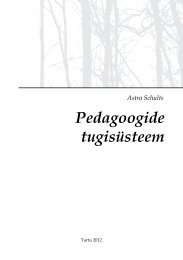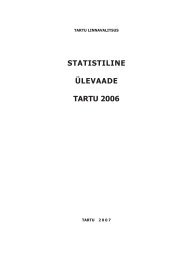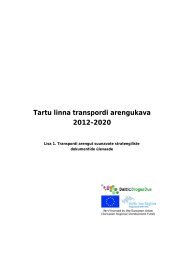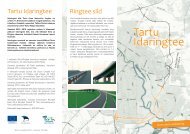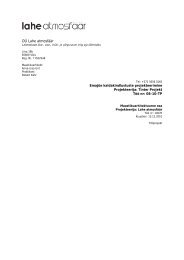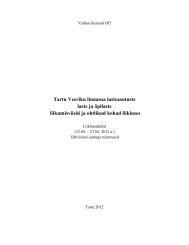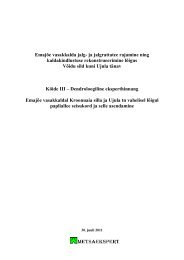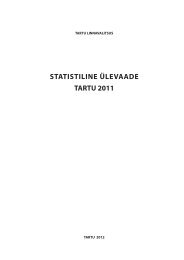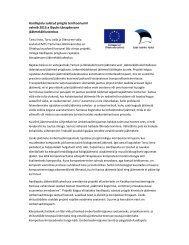Regional Biogas Development Strategy and Action Plan - Tartu
Regional Biogas Development Strategy and Action Plan - Tartu
Regional Biogas Development Strategy and Action Plan - Tartu
Create successful ePaper yourself
Turn your PDF publications into a flip-book with our unique Google optimized e-Paper software.
fossil fuels <strong>and</strong> to reduce pressure on the natural environment. The objective of the development<br />
plan is to reduce the dependence of Estonia on imported energy resources <strong>and</strong> to enhance the use<br />
of biomass as a raw material for energy which coincides with the objective of the <strong>Development</strong><br />
<strong>Plan</strong> of the Energy Sector to guarantee continuous energy supply by diversification of energy<br />
sources <strong>and</strong> more even distribution in the energy balance 30 .<br />
3.4. National <strong>and</strong> European Union regulations of construction <strong>and</strong> operational safety<br />
of a biogas plant<br />
The construction <strong>and</strong> operational safety of a biogas plant are governed by several national <strong>and</strong><br />
European Union regulations, of which the following are the most important:<br />
1) Directive of the European Parliament <strong>and</strong> Council of 23 March 1994 on the approximation of<br />
the laws of the Member States concerning equipment <strong>and</strong> protective systems intended for use in<br />
potentially explosive atmospheres (94/9/EU); <strong>and</strong><br />
2) Directive of the European Parliament <strong>and</strong> Council of 17 May 2006 on machinery, <strong>and</strong><br />
amending Directive 95/16/EU (2006/42/EU).<br />
The construction of a biogas plant must conform to the following Estonian legislation:<br />
1) Building Act, adopted on 15 May 2002;<br />
2) <strong>Plan</strong>ning Act, adopted on 13 November 2002;<br />
3) Water Act, adopted on 11 May 1994;<br />
4) Ambient Air Protection Act, adopted on 5 May 2004;<br />
5) Waste Act, adopted on 28 January 2004;<br />
6) Environmental Impact Assessment <strong>and</strong> Environmental Auditing Act, adopted on 22 February<br />
2005;<br />
5) Machinery Safety Act, adopted on 10 October 2008;<br />
7) Public Health Act, adopted on 14 June 1995;<br />
8) Public Procurement Act, adopted on 24 January 2007;<br />
9) Requirements for noise, noise level measuring <strong>and</strong> noise level tracing in equipment used<br />
outdoors <strong>and</strong> conformity assessment procedure of equipment used outdoors. Regulation no. 124<br />
of the Minister of Economic Affairs <strong>and</strong> Communications of 16 December 2009; <strong>and</strong><br />
10) Noise limit values in residential <strong>and</strong> recreational areas, dwellings <strong>and</strong> public buildings <strong>and</strong><br />
noise level measuring methods, stated in the Regulation no. 42 of the Minister of Social affairs of<br />
4 March 2002.<br />
4. Economic, social <strong>and</strong> environmental aspects<br />
4.1. <strong>Biogas</strong> production <strong>and</strong> consumption, socio-economic aspects <strong>and</strong> impacts<br />
Major socio-economic impact related to the construction of a biogas plant is:<br />
1) labour force;<br />
30<br />
<strong>Development</strong> <strong>Plan</strong> 2007 – 2013 for Enhancing the Use of Biomass <strong>and</strong> Bioenergy http://www.agri.ee/index.php?<br />
id=11014<br />
22




